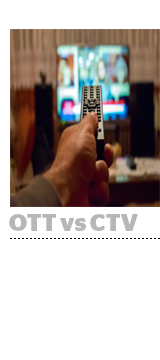
Everyone wants to talk about over-the-top (OTT) and connected TV (CTV) right now, but they’re often confused for one another. They’re also used interchangeably by many marketers, brands, and sometimes, by the most erudite reporters.
With all the TLAs (three letter acronyms) we love to employ in this industry, we thought it’d be a good idea to ask the experts how they differentiate CTV and OTV. For TV buyers, these definitions are critical, as it directly influences the way they transact across various platforms and devices.
There’s just billions of dollars riding on these definitions. No pressure, though.
So, what’s the difference between OTT and CTV?
Tal Chalozin, Co-founder and CTO, Innovid
“OTT means you are accessing content ‘over the top’ of infrastructure providers. If you’re buying bandwidth from one provider like Comcast but subscribing to Hulu, you’re going over-the-top of the provider that provided you the bandwidth. You’re using the bandwidth provider as an access layer but not as the main way you’re accessing content.
“CTV is the device by which you access content. You need an actual device to consume the content. Content is being streamed into an internet-connected app on a smart TV or similar device.
Roku, plugged into a smart TV is an example.”
Dan Robbins, Director of Ad and Programming Research, Roku
“We follow the IAB definition of OTT, which means any device that can be connected to a TV to allow for the delivery of video that’s coming from the Internet as opposed to from coaxial cable or satellite. That’s the formal way we think about it.
“Over-the-top as a term really emerged because the streaming devices or the gaming consoles actually physically sat over-the-top of your cable box in the room. And now that that feels a bit anachronistic.
“I think in many ways there appears to be a bit of semantics but [OTT and CTV] are speaking toward the same thing.”=
Alex Bailey, VP, Advanced Advertising, Publicis Media UK
“OTT is a term established in the US and until recently, not common in the UK. OTT is derived from supplying consumers with TV content over and above the legacy broadcast: analogue and cable. It’s the supply of content over an IP stream. In the UK, that means digital screen and specifically app viewing environments.
“CTV is simply a screen for consuming IP delivered content consumed through an App. This refers to both SVOD and ad supported content.”
Tom Fochetta, VP of Advertising Sales, Samsung Ads
I think of OTT as a delivery mechanism for video content. On the other hand, CTV refers to that video over IP on the largest screen in the home.
This post was syndicated from Ad Exchanger.

More Stories
Around the World: AI & Christmas, a Temu crackdown and Aussie influencers
Here’s a Short Roundup for This Week
Melanie Spencer a finalist in Campaign’s Agency of the Year Awards